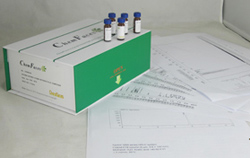Hot Products



| Catalog No. | Information |
| CFN90455 | Soyasaponin Aa Soyasaponin Aa and soyasaponin Ab dose-dependently markedly inhibit adipocyte differentiation and expression of various adipogenic marker genes, through the downregulation of the adipogenesis-related transcription factors PPARγ and C/EBPα in 3T3-L1 adipocytes. |
| CFN90773 | Soyasaponin Ab Soyasaponin Ab may represent a viable candidate for effective vaccine adjuvant, TLR4 receptor dependent pathway may be involved in immune stimulatory effects of soyasaponin Ab. Soyasaponin Ab has anti-inflammatory effects, it can inhibit colon shortening, myeloperoxidase activity, the expression of cyclooxygenase-2 (COX-2) and inducible nitric oxide synthase (iNOS), and activation of the transcription factor nuclear factor-κB (NF-κB); soyasaponin Ab (1, 2, 5, and 10 μM) can inhibit the production of NO (IC50 = 1.6 ± 0.1 uM) and prosta. Soyasaponin Aa and Ab can markedly inhibit adipocyte differentiation and expression of various adipogenic marker genes through the downregulation of the adipogenesis-related transcription factors PPARγ and C/EBPα in 3T3-L1 adipocytes. They also can prevent scopolamine-induced memory impairment in mice without the inhibition of acetylcholinesterase, exhibit memory-enhancing effects. |
| CFN90774 | Soyasaponin Ac Soyasaponin Ac can decrease the drug resistance via EMT pathway and weaken the migration ability of ovarian cancer cells. |
| CFN90722 | Soyasaponin Ba Soyasaponins(Aa, Ab, Af, Ba, Bb, and Bb') together with their derivatives may represent viable candidates for effective vaccine adjuvants due to their higher and lower or non-haemolytic effects.Soyasaponins Ab and Bb prevent scopolamine-induced memory impairment in mice without the inhibition of acetylcholinesterase. |
| CFN90456 | Soyasaponin Bb Soyasaponin Bb can suppress Eca-9706 cell growth, reverse effects on over expression of c-met, VEGF, and induce cell apoptosis through inhibiting HDAC1-NF-kappaB and activating PETEN and caspase-3 signaling pathways. |
| CFN90775 | Soyasaponin Bd 1. Soyasaponins has chemoprevention activities, it prevent H₂O₂-induced inhibition of gap junctional intercellular communication by scavenging reactive oxygen species in rat liver cells. 2. Soyasaponins can significantly decrease blood glucose, improve atherosclerotic index, and inhibit lipid peroxidation and platelet aggregation in diabetic rats, which may be useful in prevention and control of diabetes mellitus and diabetes-associated atherosclerosis. 3. Soyasaponins abundant in soybean have anti-inflammatory activities, low-dose SSs alleviated contact hypersensitivity (CHS) symptoms by attenuating inflammation and improving the intestinal microbiota composition, suggesting that dietary SSs may have beneficial effects on allergic contact dermatitis (ACD). 4. Dietary soyasaponin has inhibitory effects on 2,4-dinitrofluorobenzene-induced contact hypersensitivity in mice. |
| CFN90776 | Soyasaponin Be 1. Soyasaponins has chemoprevention activities, it prevent H₂O₂-induced inhibition of gap junctional intercellular communication by scavenging reactive oxygen species in rat liver cells. 2. Soyasaponins can significantly decrease blood glucose, improve atherosclerotic index, and inhibit lipid peroxidation and platelet aggregation in diabetic rats, which may be useful in prevention and control of diabetes mellitus and diabetes-associated atherosclerosis. 3. Soyasaponins abundant in soybean have anti-inflammatory activities, low-dose SSs alleviated contact hypersensitivity (CHS) symptoms by attenuating inflammation and improving the intestinal microbiota composition, suggesting that dietary SSs may have beneficial effects on allergic contact dermatitis (ACD). 4. Dietary soyasaponin has inhibitory effects on 2,4-dinitrofluorobenzene-induced contact hypersensitivity in mice. |
| CFN93159 | Soyasaponin II Soyasaponin II has antiviral effects, it can inhibit the replication of human cytomegalovirus, influenza virus, and human immunodeficiency virus type 1. Soyasaponin II has hepatoprotective actions towards immunologically induced liver injury on primary cultured rat hepatocytes. It can inhibit the conversion of fibrinogen to fibrin, it also can promote activation of the fibrinolytic system in a plasminogen-containing fibrin plate. Soyasaponins are a potential antitumor compound and the apoptosis induced by soyasaponins is a key antitumor mechanism. |
| CFN91596 | Soyasaponin III Soyasaponin III, a monodesmodic oleanane triterpenoid, is one of the main potentially bioactive saponins found in soy (Glycine max) and related products. Soyasaponin III can induce apoptosis in Hep-G2 cells. Effects on immunohemolysis: Soyasaponin III plays an active role in anticomplementary activity in vitro |
| CFN93251 | Soyasaponin IV Soyasaponin IV has hepatoprotective activity.It also has antimutagenic activity in mammalian cells. |